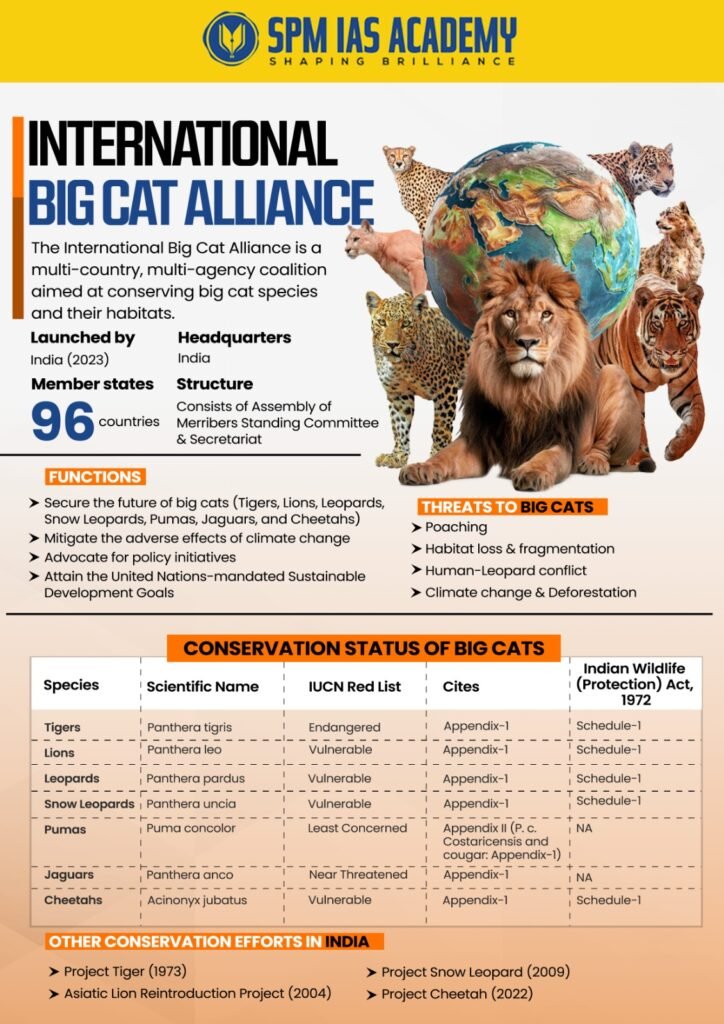India launched the International Big Cat Alliance (IBCA) in 2023 to raise awareness and help conserve seven big cat species: tiger, lion, leopard, snow leopard, cheetah, jaguar, and puma. IBCA, based in India, aims to protect wildlife, control poaching, and prevent illegal trading. It encourages countries to collaborate, share information, conduct research, and support conservation efforts.
On the occasion of Project Tiger’s 50th anniversary, IBCA works to build stronger conservation networks, arrange cooperative projects, and promote sustainable wildlife management. It provides strong leadership for India in biodiversity conservation.
In this article, we will look into the International Big Cat Alliance (IBCA) to deepen your understanding of its definition, objectives, government structure, member countries, and India’s role. This information will be valuable for both the preliminary and main exams.
Why is the Topic in the News?
The International Big Cat Alliance (IBCA) officially became a treaty-based intergovernmental organization and an international legal entity on January 23, 2025. Its headquarters are in India.
What is the International Big Cat Alliance?
The International Big Cat Alliance (IBAC) is a global initiative started by India in 2024. Its goal is to protect the world’s seven major big cat species through joint efforts, sharing knowledge, and building skills.
The National Tiger Conservation Authority (NTCA) coordinates the initiative under the Ministry of Environment, Forest, and Climate Change.
| International Big Cat Alliance UPSC Notes | |
| Launch Year | 2023 |
| Initiated By | India |
| Objective | Conservation of seven big cat species—tiger, lion, leopard, snow leopard, cheetah, jaguar, and puma |
| Headquarters | India |
| Key Focus Areas | Wildlife conservation, anti-poaching efforts, tackling illegal wildlife trade, and transboundary cooperation |
| Significance | Strengthens global biodiversity conservation, showcases India’s leadership in environmental initiatives |
| Budget Allocation | ₹150 crore for five years (2023-24 to 2027-28) |
| Governance Structure | Assembly of Members, Standing Committee, Secretariat |
| Relevant UPSC Topics | GS Paper III (Environment & Ecology), International Relations |
1. When was the International Big Cat Alliance established?
March 2024, following PM Narendra Modi’s announcement during the 50th anniversary of Project Tiger in April 2023.
2. What are the objectives of the International Big Cat Alliance?
Below are the objectives of the big cat conservation:
- Facilitate global collaboration for the preservation of big cats.
- Replicate successful conservation practices across countries.
- Build a shared pool of financial, technical, and institutional resources.
- Address gaps in capacity building, data sharing, and financing.
- Improve livelihoods and climate resilience in international wildlife protection.
3. What are the big cats covered?
Tiger, Leopard, Lion, Cheetah, Snow Leopard, Jaguar, and Puma.
Need for the International Big Cat Alliance (IBCA) UPSC Current Affairs
India has launched the International Big Cat Alliance (IBCA), a global effort focused on the protection and conservation of seven major big cat species: tiger, cheetah, jaguar, leopard, lion, puma, and snow leopard. This alliance aims to improve conservation efforts beyond Project Tiger, which started five decades ago to protect the declining big cat population and their habitats.
According to the Ministry of Environment, Forest, and Climate Change (MoEF&CC), IBCA will involve range nations, or countries that host these species, to strengthen conservation strategies for these apex predators. The global wildlife alliances will act as a platform for sharing knowledge, enabling member nations to exchange expertise and help recover big cat populations in their possible habitats.
Additionally, the International Big Cat Alliance will work with existing intergovernmental forums focused on specific big cat species. This will further support global conservation efforts through collaboration, resource mobilization, and policy advocacy, thus making it an important UPSC environmental topic.
What is the Governing Structure of the International Big Cat Alliance?
The International Big Cat Alliance (IBCA) UPSC current affairs governance includes an Assembly of Members, a Standing Committee, and a Secretariat, all based in India. This structure ensures global coordination.
1. Member Countries
- 95 Range Countries are eligible, where the species naturally occurs.
- 25 countries had joined by September 2024, including Bangladesh, Nigeria, Peru, and Ecuador. All UN member states can participate through a Note Verbale.
- Currently, IBCA has four member nations: India, Nicaragua, Eswatini, and Somalia.
2. Budgetary Allocation
The Union Cabinet has approved a one-time financial support of ₹150 crore for the alliance, covering five years from 2023-24 to 2027-28.
3. Governance Structure
IBCA’s framework consists of an Assembly of Members, a Standing Committee, and a Secretariat, with headquarters in India.
4. Organizational Model
The governance structure draws inspiration from the International Solar Alliance (ISA). A Director-General (DG) is appointed by the Ministry of Environment, Forest and Climate Change (MoEFCC) to oversee its operations.
What are the Key Functions of the International Big Cat Alliance (IBCA)?
Below are the key functions of the IBCA for big cat conservation:
- IBCA compiles proven conservation strategies from member nations into a shared resource to provide scalable, science-based solutions.
- It organizes training programs, technical workshops, and institutional exchanges to develop local expertise in big cat conservation.
- IBCA funds and promotes scientific studies, drives policy changes, raises conservation awareness, and connects it to sustainable livelihoods.
- The Alliance serves as a global support system, offering financial and technical help to countries with limited conservation resources.
- It introduces new technologies and encourages partnerships across sectors to tackle issues like habitat loss and prey depletion.
- IBCA allows member countries to share data, intelligence, and collaborative strategies to fight poaching and illegal wildlife trade.
What are the 2025 Summit Outcomes?
1. First General Assembly Held: The inaugural Assembly of IBCA took place in New Delhi on June 16, 2025. This marked a global milestone in big cat diplomacy.
2. Nine Nations Participated: Countries like Bhutan, Cambodia, Eswatini, and Kazakhstan joined India to talk about working together on conservation goals.
3. India Designated as HQ: The Headquarters Agreement was ratified, officially making India the permanent secretariat of IBCA.
4. Bhupender Yadav Elected President: India’s Environment Minister was unanimously chosen as the first President of the Alliance, showcasing India’s leadership.
5. Funding Commitment by India: India set aside ₹150 crore (2023–28) to help with IBCA’s initial setup, coordination, and capacity building efforts around the world.
IBCA Big Cat Conservation Efforts in India
- Asiatic Lion Conservation Project
- Project Snow Leopard
- Project Cheetah
- Wildlife Protection Act, 1972
- National Board for Wildlife (NBWL)
- Project Tiger
| Habitat and Gestation Period of Big Cats | ||
| Big Cats | Habitat | Gestation Period (Days) |
| Tiger | Temperate, tropical, and evergreen forests, mangrove, and grasslands | 95-110 |
| Cheetah | Shrublands, grasslands, savannas, and temperate to hot deserts | 90-95 |
| Leopard | Forests, subtropical and sub-tropical regions, Savannas, deserts, and rocky and mountainous regions | 90-105 |
| Lion | Open plains, dry thorn forests, and grasslands | 100-110 |
| Snow Leopard | Northern and Central Asia Mountains | 90-105 |
Conclusion
The International Big Cat Alliance (IBCA) is a global effort to conserve seven big cat species through collaboration, standardized methods, and community involvement. It symbolizes global unity and aims for a future where humans and big cats coexist peacefully.
Frequently Asked Questions
1. How can countries join IBCA?
Countries can join the International Big Cat Alliance (IBCA) by expressing their intent via a Note Verbale and signing the Framework Agreement with India’s Ministry of External Affairs.
2. How many countries are members of IBCA?
As of September 2024, four countries—India, Nicaragua, Eswatini, and Somalia—have signed the Framework Agreement and officially joined IBCA.
3. What is the governance structure of IBCA?
IBCA consists of an Assembly of Members, a Standing Committee, and a Secretariat, with its headquarters in India.
4. What are the 5 Big Cats in India?
The names of 5 big cats in India are Bengal Tiger, Indian Leopard, Snow Leopard, Clouded Leopard, and Asiatic Lion.
5. How does IBCA contribute to global conservation?
IBCA provides a platform for knowledge-sharing, research collaboration, and financial support, helping range countries implement effective conservation strategies.
6. What are the International Big Cat Alliance UPSC notes?
IBCA is a global treaty-based intergovernmental organization launched by India in 2023 to conserve seven big cat species—tiger, lion, leopard, snow leopard, cheetah, jaguar, and puma.
7. What is the mission of IBCA?
IBCA aims to strengthen global cooperation for big cat conservation, prevent illegal wildlife trade, protect natural habitats, and mobilize financial and technical resources.










